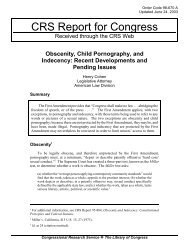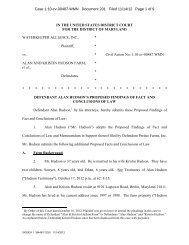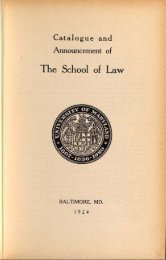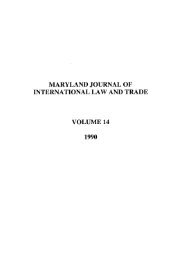Reducing Teen Pregnancy: Adolescent Family Life and Abstinence ...
Reducing Teen Pregnancy: Adolescent Family Life and Abstinence ...
Reducing Teen Pregnancy: Adolescent Family Life and Abstinence ...
You also want an ePaper? Increase the reach of your titles
YUMPU automatically turns print PDFs into web optimized ePapers that Google loves.
CRS-4<br />
the Title V abstinence-only block grant through March 31, 2005. 5 P.L. 105-33, enacted<br />
in 1997, included funding for a scientific evaluation of the abstinence education<br />
programs; P.L. 106-554 required an interim report. Mathematica Policy Research won<br />
the contract for the evaluation. (See The Evaluation of <strong>Abstinence</strong> Education Programs<br />
Funded Under Title V Section 510:Interim Report [http://aspe.hhs.gov/hsp/abstinence02/<br />
index.htm].) The final report is due in 2005.<br />
To ensure that the abstinence-only message is not diluted, the law (P.L. 104-193,<br />
Section 510 of the Social Security Act) stipulated that the term “abstinence education”<br />
means an educational or motivational program that — (1) has as its exclusive purpose,<br />
teaching the social, psychological, <strong>and</strong> health gains of abstaining from sexual activity; (2)<br />
teaches abstinence from sexual activity outside of marriage as the expected st<strong>and</strong>ard for<br />
all school-age children; (3) teaches that abstinence is the only certain way to avoid<br />
out-of-wedlock pregnancy, STDs, <strong>and</strong> associated health problems; (4) teaches that a<br />
mutually faithful monogamous relationship within marriage is the expected st<strong>and</strong>ard of<br />
human sexual activity; (5) teaches that sexual activity outside of marriage is likely to have<br />
harmful psychological <strong>and</strong> physical effects; (6) teaches that bearing children<br />
out-of-wedlock is likely to have harmful consequences for the child, the child’s parents,<br />
<strong>and</strong> society; (7) teaches young people how to reject sexual advances <strong>and</strong> how alcohol <strong>and</strong><br />
drug use increases vulnerability to sexual advances; <strong>and</strong> (8) teaches the importance of<br />
attaining self-sufficiency before engaging in sex.<br />
What Is <strong>Abstinence</strong>?<br />
It is becoming clear that parents, teachers, <strong>and</strong> teenagers are not in agreement on what constitutes<br />
abstinence. <strong>Teen</strong>s are more likely than adults to believe that behaviors that cannot result in pregnancy<br />
constitute abstinence. Because pregnancy prevention together with avoidance of STDs are dual goals<br />
of the abstinence education program, some observers contend that it is time for programs to explicitly<br />
define what constitutes sexual activity. Others contend that specifying behaviors other than sexual<br />
intercourse violates a child’s innocence <strong>and</strong> may provide ideas for experimentation. Source: Lisa Remez,<br />
“Oral Sex among <strong>Adolescent</strong>s: Is It Sex or Is It <strong>Abstinence</strong>?” <strong>Family</strong> Planning Perspectives (Alan<br />
Guttmacher Institute), 32(6), Nov-Dec. 2000, pp. 298-304.<br />
In FY2003, every state except California (<strong>and</strong> several territories) sponsored an<br />
abstinence education program. These programs launch media campaigns to influence<br />
attitudes <strong>and</strong> behavior, develop abstinence education curricula, revamp sexual education<br />
classes, <strong>and</strong> implement other activities focused on abstinence education. State funding<br />
is based on the proportion of low-income children in the state as compared to the national<br />
total. In FY2003, federal abstinence education funding ranged from $69,855 in Vermont<br />
to $4,922,091 in Texas.<br />
Appropriations for 2001, 2002, 2003, <strong>and</strong> 2004. P.L. 106-246 appropriated<br />
an additional $20 million for FY2001 to HHS under the Special Projects of Regional <strong>and</strong><br />
National Significance (SPRANS) program (funded by the MCH Block grant) for<br />
abstinence education to bolster the abstinence-only message for adolescents aged 12<br />
through 18. P.L. 106-554 also reinforced the abstinence education program by providing<br />
5 H.R. 4, the welfare reform reauthorization bill, which was passed by the House on Feb. 13, 2003<br />
<strong>and</strong> approved, with amendments, by the Senate Finance Committee on Sept. 10, 2003, would<br />
extend funding for the $50 million abstinence-only block grant through FY2008. Although H.R.<br />
4 was debated on the Senate floor during the period Mar. 29-Apr. 1, 2004, consideration of the<br />
bill was not completed.















